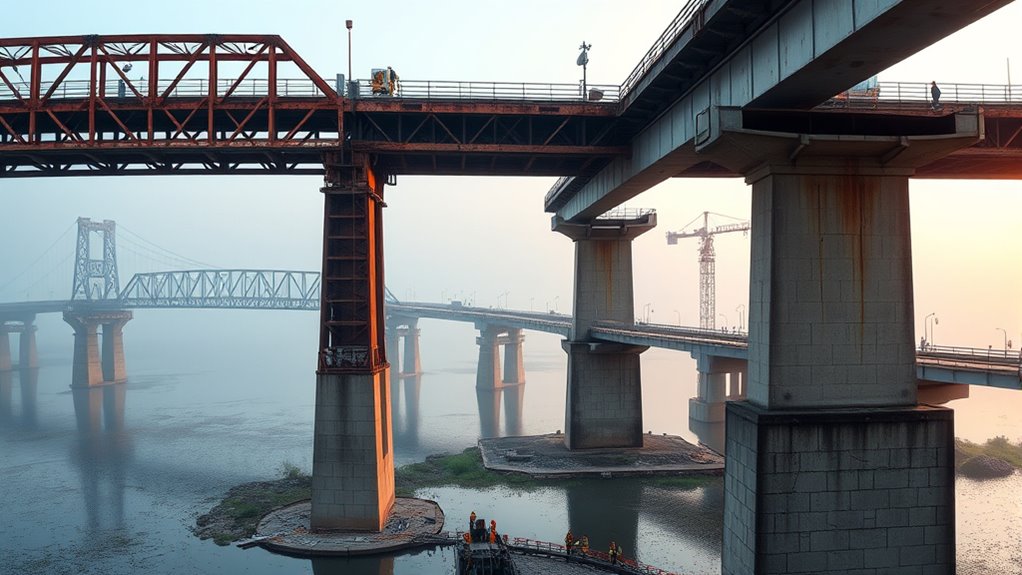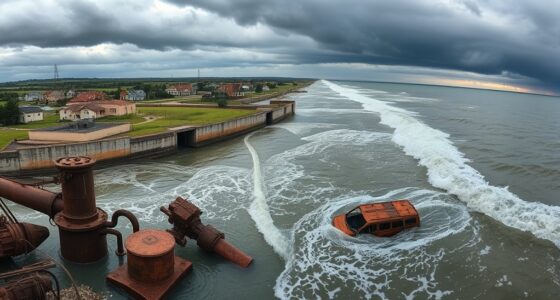The U.S. is addressing the silent crisis of aging bridges by investing in new funding and cutting-edge technologies like sensors and real-time monitoring to catch deterioration early. Local and state governments are working on repair plans, often with federal grants and innovative partnerships. Stricter inspections and community efforts also play a role in prevention. If you want to learn how these efforts are making a difference and what’s coming next, keep exploring the evolving safety initiatives.
Key Takeaways
- The U.S. is investing in advanced sensor and monitoring technologies for early detection of bridge deterioration.
- Federal, state, and local agencies are allocating funds and grants to repair and replace aging bridges.
- Stricter inspection protocols and maintenance schedules are being implemented nationwide.
- Public-private partnerships and community campaigns raise awareness and support infrastructure safety efforts.
- Prioritizing the most vulnerable bridges ensures targeted, effective interventions to prevent collapses.

Are you aware that several bridges in your area are teetering on the brink of collapse? This quiet crisis is a stark reminder of how essential bridge safety truly is. Many of these structures, some decades old, haven’t received the necessary attention or funding to keep them secure. The reality is that aging infrastructure, if left unchecked, can pose serious hazards not just to vehicles but to lives. The U.S. government and local authorities are now recognizing this threat and taking steps to address it, but the challenge remains massive.
One of the biggest hurdles in maintaining and upgrading bridges is infrastructure funding. It’s no secret that fixing and replacing aging structures requires significant investment. Unfortunately, funding often falls short, especially in smaller communities that lack the resources to prioritize bridge safety. While federal funds are allocated through programs like the Infrastructure Investment and Jobs Act, these allocations still struggle to keep pace with the growing backlog of repairs needed nationwide. When funding is limited, critical inspections and maintenance get delayed, increasing the risk of structural failure.
Efforts are underway to improve the situation. The federal government has increased investments aimed at inspecting and rehabilitating vulnerable bridges. These initiatives focus on identifying the most at-risk structures, prioritizing repairs, and deploying innovative technology to assess bridge health more accurately. For example, some agencies now use sensors and real-time monitoring systems to detect early signs of deterioration, allowing for proactive maintenance rather than reactive fixes. These advancements help bridge safety become more manageable and less costly over time.
Local governments are also stepping up, often leveraging federal grants and public-private partnerships to fund bridge repairs. Many states have initiated detailed bridge replacement programs to address their most critical vulnerabilities. In some cases, they’ve implemented stricter inspection standards and maintenance schedules to prevent minor issues from turning into catastrophic failures. Community awareness campaigns are also spreading, emphasizing the importance of reporting issues like cracks or unusual movements early on.
Despite these efforts, the scale of the problem means there’s still a long road ahead. The key to making real progress lies in sustained, increased infrastructure funding, combined with innovative inspection technologies and stronger prioritization of the most dangerous bridges. You play a role here, too—by staying informed about local infrastructure projects, advocating for better funding, and reporting concerns about bridge safety. Additionally, adopting new inspection technologies can significantly improve early detection of issues. The collective effort can help guarantee these essential structures are kept secure, protecting lives and keeping commerce flowing smoothly. The challenge is significant, but with continued focus and investment, the silent crisis of bridges near collapse can be addressed before tragedy strikes.
Frequently Asked Questions
How Are Bridge Inspections Prioritized Across Different States?
You’ll find that inspection protocols and state priorities shape how bridges get inspected across different states. States often prioritize bridges based on factors like age, traffic volume, and structural condition. Some follow federal guidelines strictly, while others adapt inspection schedules to local needs. This approach helps guarantee the most critical bridges are checked first, reducing risks and maintaining safety, even if the specifics vary from state to state.
What Innovative Materials Are Being Used for Bridge Repairs?
Imagine a bridge holding up more than just traffic—it’s a lifeline. You’re likely unaware of the innovative materials like fiber-reinforced polymers and self-healing concretes that engineers now use for repairs. These advanced repair techniques strengthen structures and extend their lifespan, ensuring safety. By embracing such cutting-edge materials, you help protect communities and preserve critical infrastructure, transforming potential disaster into resilience.
How Does Climate Change Impact Bridge Infrastructure Stability?
You should understand that climate change affects bridge infrastructure stability by challenging its climate resilience. Increased temperatures, heavy rainfall, and flooding cause wear and deterioration. To guarantee safety, engineers focus on structural adaptation, designing bridges that withstand extreme weather events. By incorporating resilient materials and innovative engineering solutions, you can help protect vital transportation links from climate-related damage, ensuring they remain safe and functional for years to come.
Are There Community Programs Supporting Bridge Safety Awareness?
Community programs are like bridges connecting people to safety, emphasizing the importance of safety education and awareness. You can participate in local workshops or outreach efforts that focus on bridge safety, helping you recognize signs of deterioration. These initiatives promote community engagement, making everyone more vigilant and informed. By supporting or joining such programs, you contribute to preventing accidents and ensuring the infrastructure remains safe for all.
What Funding Opportunities Are Available for Urgent Bridge Repairs?
You can explore various bridge funding options and repair grants available through federal, state, and local programs. The federal government offers grants like the Highway Bridge Program, which supports urgent repairs. State transportation departments often have dedicated funds for bridge maintenance. Additionally, you might find opportunities through infrastructure initiatives or emergency repair funds, which aim to address critical bridge safety issues quickly and effectively.
Conclusion
You can’t ignore the fact that these crumbling bridges are like ticking time bombs waiting to release disaster. With the U.S. stepping up efforts, it’s as if the nation has suddenly become a superhero rushing to save lives. If we don’t act now, we risk a catastrophe that could shake the very foundation of our communities. But thanks to these bold initiatives, hope’s on the horizon—just in time to prevent chaos from crashing down around us.
Amina brings over a decade of journalism experience to her role as Editor-in-Chief. Under her leadership, Exquisite Post has flourished, maintaining the highest standards of integrity and excellence. Amina’s commitment to truth and her visionary approach guide the editorial team in producing impactful news stories that resonate with our audience.










